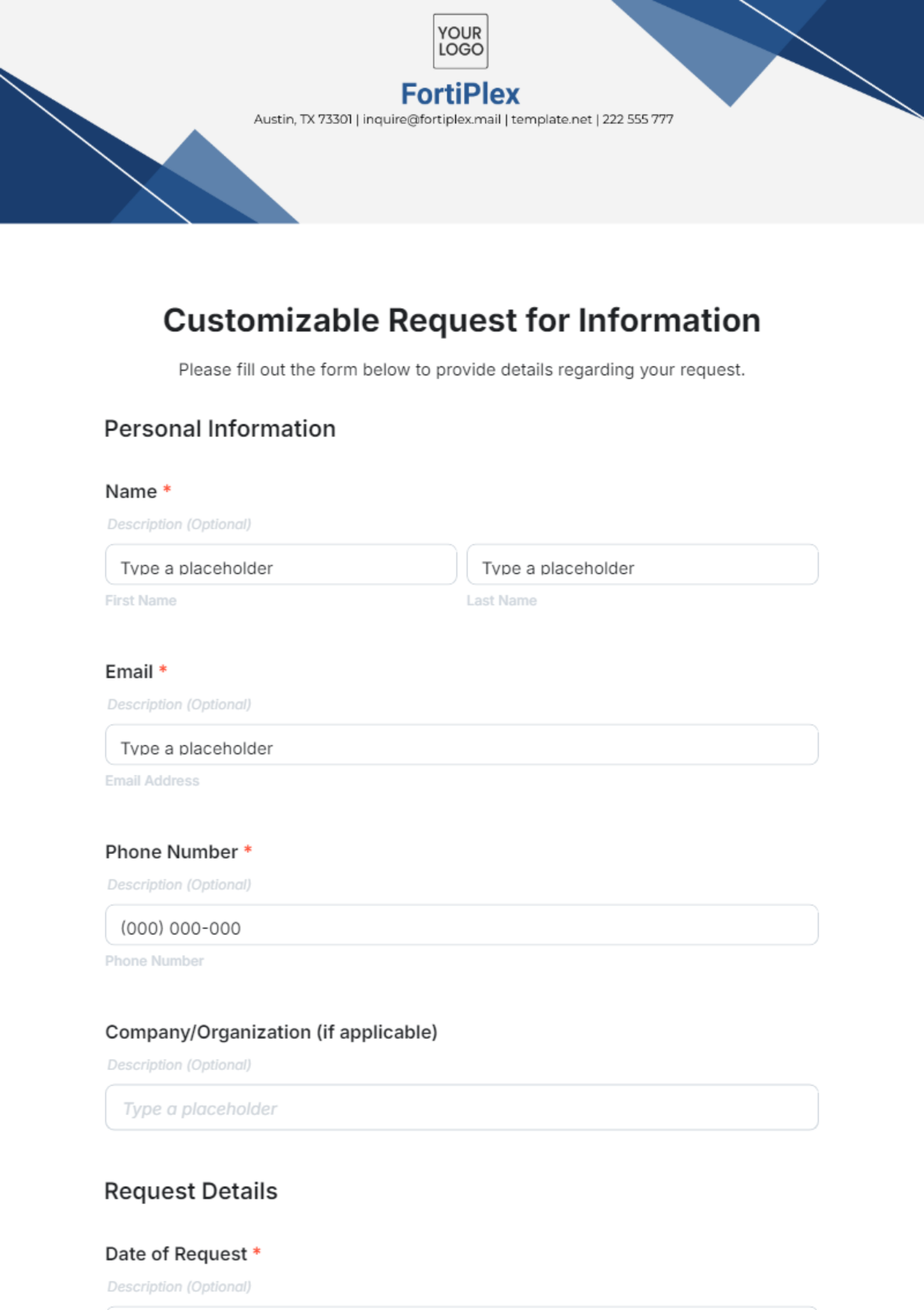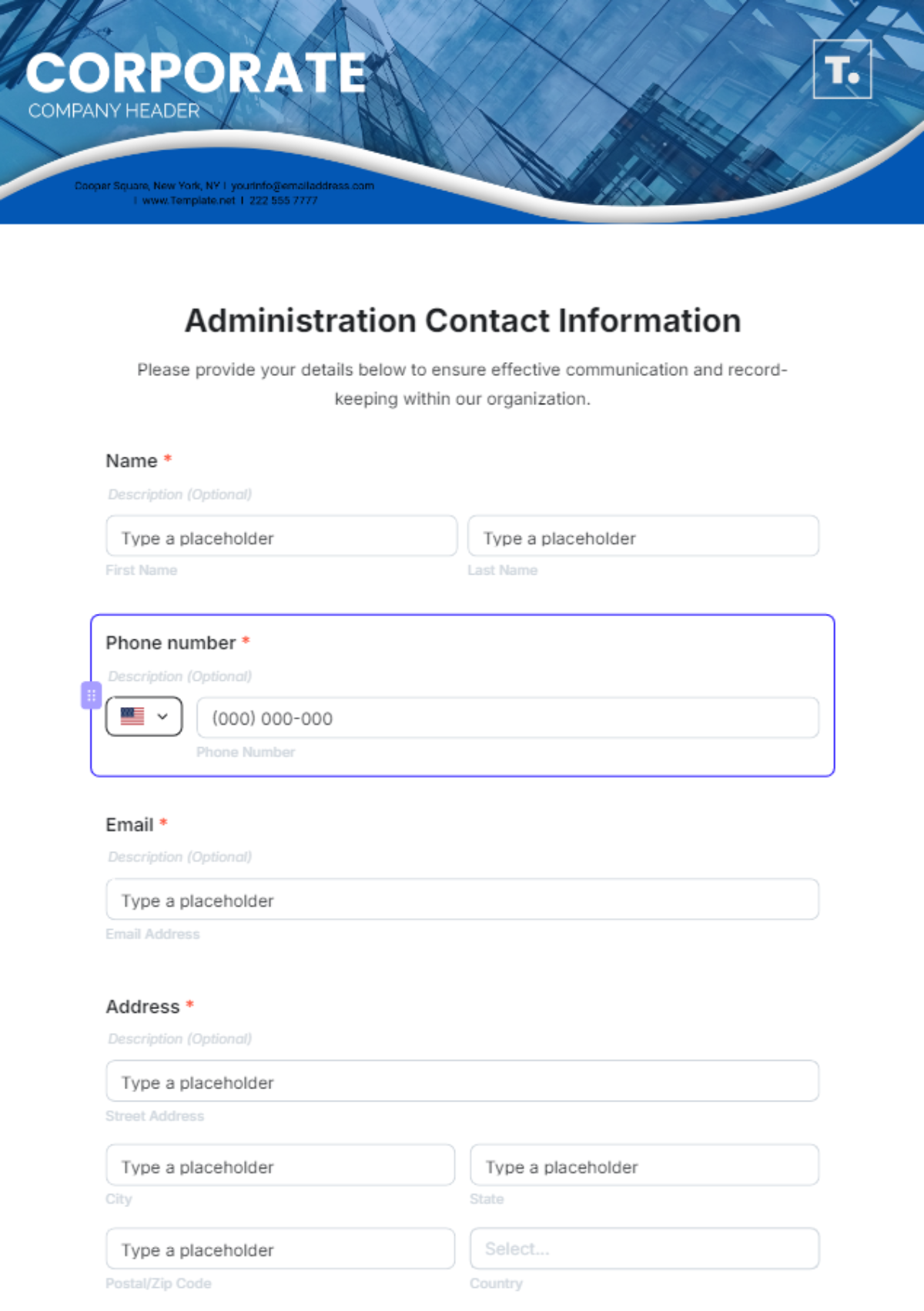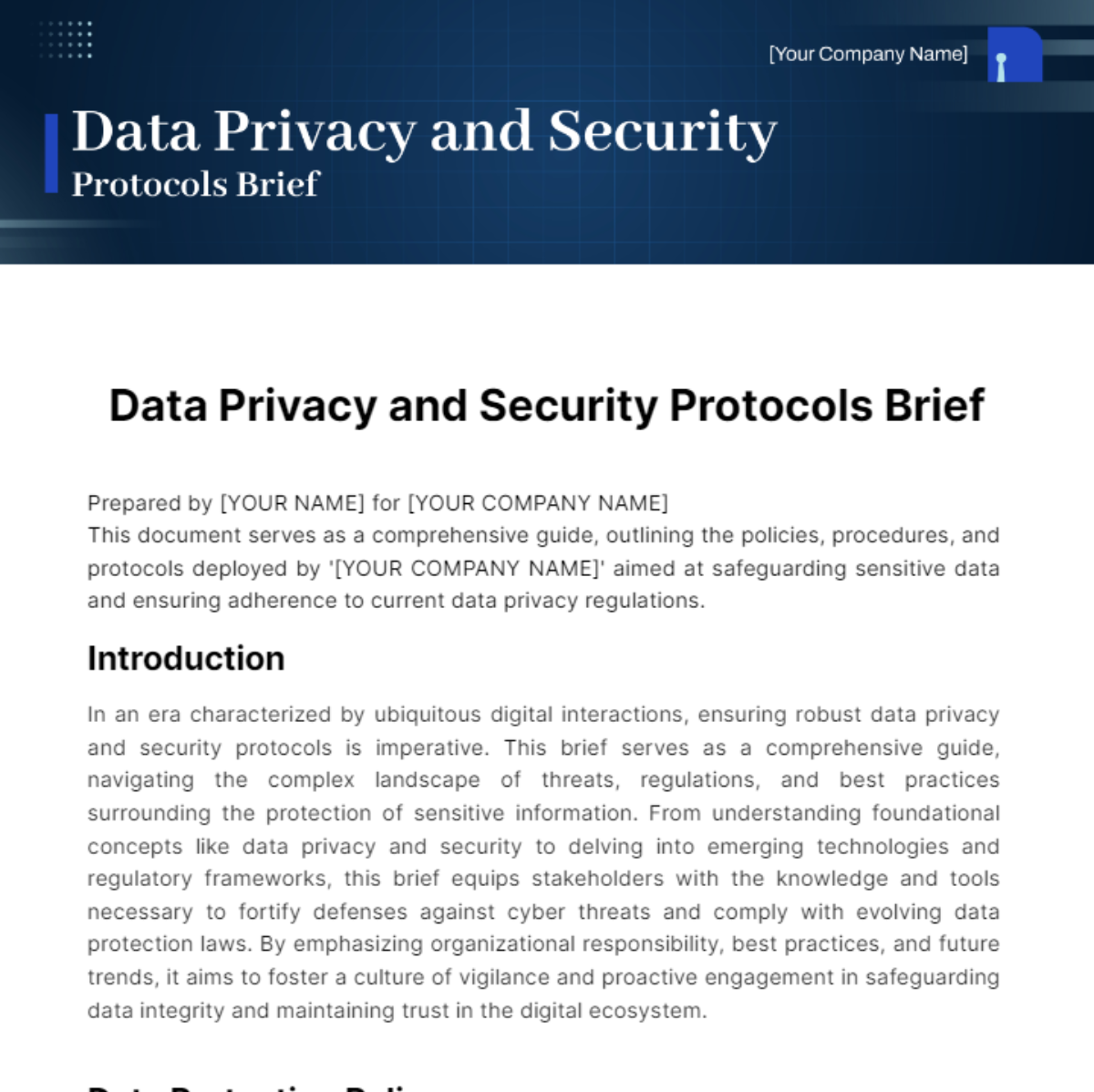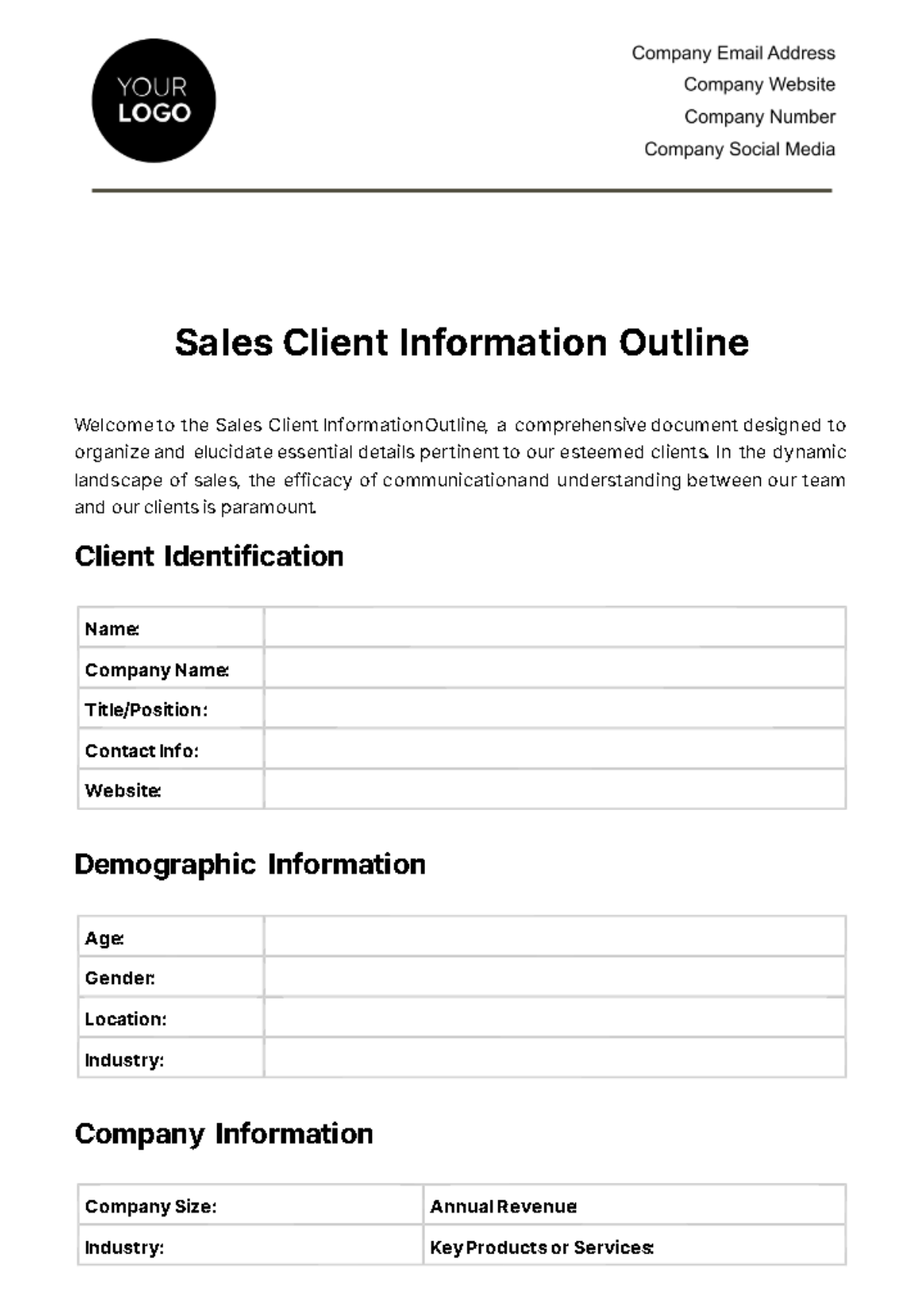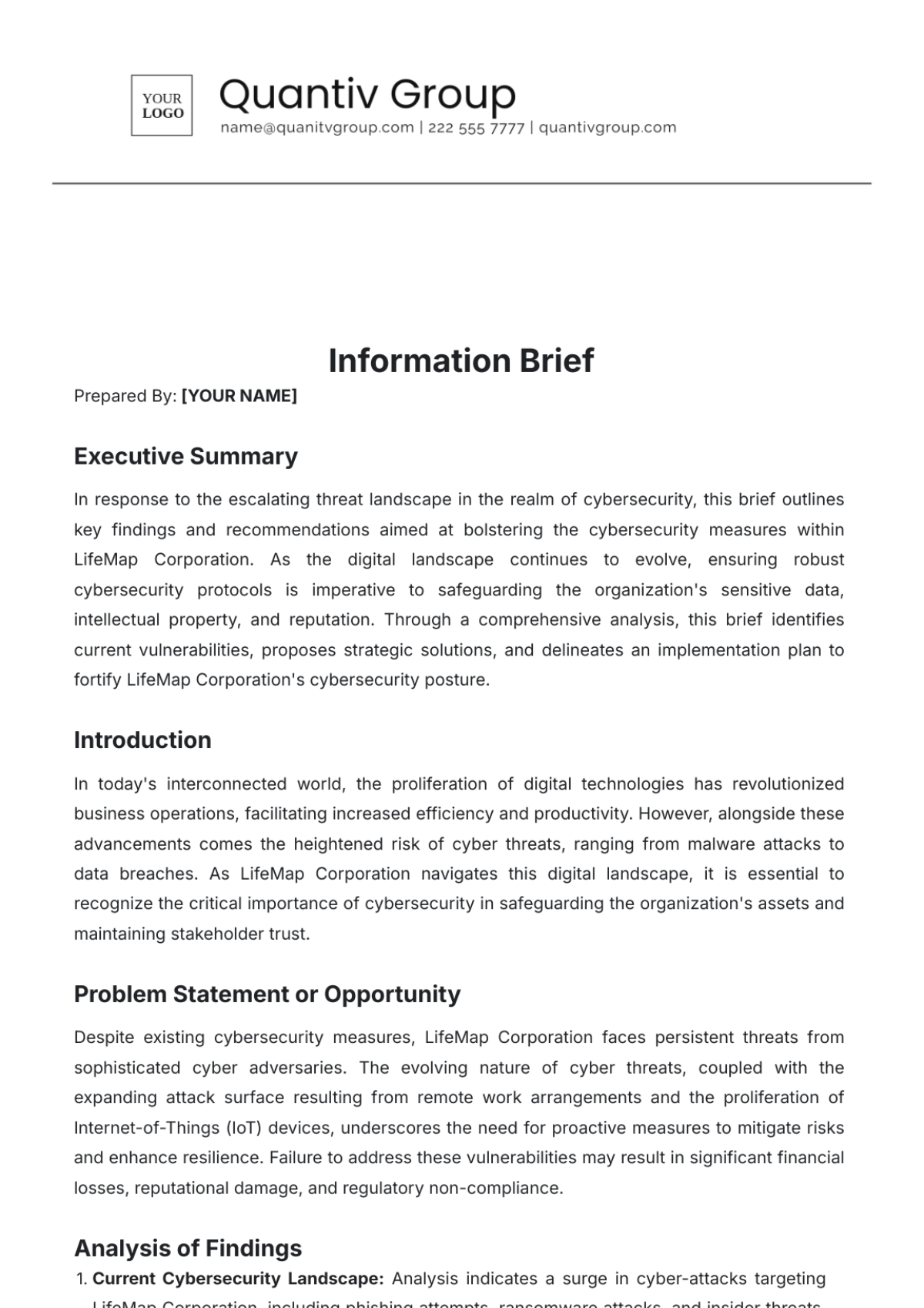Data Privacy and Security Protocols Brief
Prepared by [YOUR NAME] for [YOUR COMPANY NAME]
This document serves as a comprehensive guide, outlining the policies, procedures, and protocols deployed by '[YOUR COMPANY NAME]' aimed at safeguarding sensitive data and ensuring adherence to current data privacy regulations.
Introduction
In an era characterized by ubiquitous digital interactions, ensuring robust data privacy and security protocols is imperative. This brief serves as a comprehensive guide, navigating the complex landscape of threats, regulations, and best practices surrounding the protection of sensitive information. From understanding foundational concepts like data privacy and security to delving into emerging technologies and regulatory frameworks, this brief equips stakeholders with the knowledge and tools necessary to fortify defenses against cyber threats and comply with evolving data protection laws. By emphasizing organizational responsibility, best practices, and future trends, it aims to foster a culture of vigilance and proactive engagement in safeguarding data integrity and maintaining trust in the digital ecosystem.
Data Protection Policy
This Data Protection Policy outlines our commitment to safeguarding the privacy and security of personal data entrusted to us. We recognize the importance of protecting the confidentiality, integrity, and availability of this data and are dedicated to complying with applicable data protection laws and regulations.
Scope This policy applies to all personal data collected, processed, stored, or transmitted by our organization, regardless of the format or medium. It encompasses data collected from customers, employees, contractors, partners, and other stakeholders.
Principles Our approach to data protection is guided by the following principles:
Lawfulness, Fairness, and Transparency: We collect and process personal data lawfully, fairly, and transparently, with clear purposes disclosed to data subjects.
Purpose Limitation: Personal data is collected for specified, explicit, and legitimate purposes and not further processed in a manner incompatible with those purposes.
Data Minimization: We collect and process only the minimum amount of personal data necessary to fulfill our purposes.
Accuracy: We strive to ensure that personal data is accurate, kept up to date, and relevant for the purposes for which it was collected.
Security: We implement appropriate technical and organizational measures to protect personal data against unauthorized or unlawful processing, accidental loss, destruction, or damage.
Accountability: We take responsibility for compliance with data protection laws and regulations, including implementing appropriate measures to demonstrate compliance.
Data Collection and Processing
We collect personal data only for specified purposes and with the consent of the data subject whenever required.
Personal data is processed lawfully and fairly, and individuals are informed about the processing activities.
We ensure that the personal data collected is relevant, adequate, and limited to what is necessary for the intended purposes.
Data Security
We implement appropriate technical and organizational measures to protect personal data against unauthorized or unlawful processing and accidental loss, destruction, or damage.
Access to personal data is restricted to authorized personnel who need access to perform their duties.
We regularly review and update our security measures to address emerging threats and vulnerabilities.
Data Subject Rights
We respect the rights of data subjects, including the right to access, rectify, erase, restrict processing, and data portability.
Data subjects are provided with mechanisms to exercise their rights, and requests are handled promptly and by applicable laws.
Data Breach Response
We have procedures in place to detect, assess, and respond to data breaches promptly.
In the event of a data breach, we notify affected individuals and relevant authorities as required by law and take appropriate remedial actions.
Training and Awareness
We provide regular training and awareness programs to our employees on data protection policies, procedures, and best practices.
Employees are required to comply with this policy and undergo periodic assessments to ensure understanding and adherence.
Compliance and Monitoring
Compliance with this policy is monitored regularly through audits, assessments, and reviews.
Any breaches of this policy are investigated promptly, and corrective actions are taken to prevent recurrence.
Policy Review and Updates
This policy is reviewed periodically and updated as necessary to reflect changes in applicable laws, regulations, or organizational processes.
Employees are notified of any updates to this policy, and training is provided as needed to ensure understanding and compliance.
Conclusion This Data Protection Policy reflects our commitment to protecting the privacy and security of personal data and outlines the principles, procedures, and responsibilities governing data protection within our organization. By adhering to this policy and implementing appropriate measures, we aim to maintain trust and confidence in our handling of personal data and comply with legal and regulatory requirements.
Data Privacy Procedures
These Data Privacy Procedures detail the steps and protocols that our organization follows to uphold data privacy principles and comply with relevant laws and regulations. We recognize the importance of protecting the privacy of personal data and are committed to implementing procedures to ensure its confidentiality, integrity, and security.
Data Collection and Consent
We clearly define the purposes for which personal data is collected and ensure that individuals provide informed consent before collecting their data.
Data collection forms and processes include information about the purposes of data processing, the legal basis for processing, and the rights of data subjects.
Data Minimization and Retention
We collect and retain only the minimum amount of personal data necessary to fulfill specific purposes.
Personal data is retained only for as long as necessary to achieve the purposes for which it was collected, following legal requirements and business needs.
Data Processing and Confidentiality
Personal data is processed lawfully, fairly, and transparently, with appropriate safeguards in place to protect confidentiality.
Access to personal data is restricted to authorized personnel who require access to perform their duties, and confidentiality agreements are in place where necessary.
Data Security Measures
We implement technical and organizational measures to protect personal data against unauthorized access, disclosure, alteration, and destruction.
Measures include encryption, access controls, regular security assessments, and staff training on data security best practices.
Data Subject Rights
We respect the rights of data subjects, including the right to access, rectify, erase, restrict processing, and data portability.
Requests from data subjects to exercise their rights are promptly acknowledged and processed following applicable laws and regulations.
Data Transfer and Sharing
When transferring personal data to third parties or international jurisdictions, we ensure that appropriate safeguards are in place to protect data privacy rights.
Data-sharing agreements are established with third parties, outlining their responsibilities for data protection and confidentiality.
Incident Response and Breach Notification
We have procedures in place to detect, assess, and respond to data breaches promptly.
In the event of a data breach, affected individuals and relevant authorities are notified by legal requirements.
Training and Awareness
We provide regular training and awareness programs to employees on data privacy principles, procedures, and their roles and responsibilities in protecting personal data.
Employees are educated about the importance of data privacy and their obligations under relevant laws and regulations.
Compliance Monitoring and Review
Compliance with these procedures is monitored through audits, assessments, and reviews.
Procedures are periodically reviewed and updated to reflect changes in laws, regulations, and organizational processes.
Conclusion These Data Privacy Procedures outline our commitment to protecting the privacy and security of personal data. By adhering to these procedures and implementing appropriate measures, we aim to maintain the trust and confidence of individuals whose data we handle and comply with legal and regulatory requirements.
Data Privacy Protocols
Data Privacy Protocols serve as a framework to ensure the responsible and lawful handling of personal data within our organization. These protocols are designed to protect the privacy rights of individuals, uphold confidentiality, and comply with applicable data protection laws and regulations.
Data Classification and Inventory
We classify data based on its sensitivity and assign appropriate levels of protection.
A comprehensive inventory of personal data is maintained, detailing its types, sources, and processing activities.
Data Access Controls
Access to personal data is restricted to authorized personnel based on the principle of least privilege.
User authentication mechanisms, role-based access controls, and encryption are implemented to safeguard data access.
Data Processing Transparency
We provide transparent information to individuals about how their data is processed, including purposes, legal basis, and rights.
Privacy notices and consent mechanisms are utilized to inform individuals about data processing activities.
Data Minimization and Retention
Personal data is collected and retained only for specified, explicit, and legitimate purposes.
Data minimization principles are applied to limit the collection and storage of unnecessary personal data.
Data Transfer and International Compliance
When transferring personal data internationally, we ensure compliance with data protection laws and implement appropriate safeguards.
Standard contractual clauses, binding corporate rules, or adequacy decisions are utilized for lawful data transfers.
Data Security Measures
Technical and organizational measures are implemented to protect personal data against unauthorized access, disclosure, alteration, and destruction.
Encryption, pseudonymization, and regular security assessments are employed to maintain data security.
Data Subject Rights Management
Procedures are established to facilitate the exercise of data subject rights, including access, rectification, erasure, and objection.
Requests from data subjects are promptly addressed within the prescribed timelines set by data protection laws.
Incident Response and Breach Management
Incident response plans are in place to detect, assess, and respond to data breaches promptly.
Data breach notification procedures are followed to notify affected individuals and relevant authorities as required by law.
Employee Training and Awareness
Employees receive regular training on data privacy protocols, including their roles and responsibilities in protecting personal data.
Awareness campaigns promote a culture of privacy and encourage compliance with data privacy protocols.
Continuous Monitoring and Improvement
Compliance with data privacy protocols is monitored through audits, assessments, and reviews.
Feedback mechanisms are utilized to identify areas for improvement and implement corrective actions.
Data Privacy Protocols form the cornerstone of our commitment to protecting personal data. By adhering to these protocols and implementing robust measures, we strive to maintain the trust and confidence of individuals whose data we handle and ensure compliance with data protection laws and regulations.
Compliance with Data Privacy Regulations
Compliance with data privacy regulations is essential to protect the rights of individuals and maintain trust in our organization. This document outlines our commitment to adhering to relevant data privacy regulations and establishes protocols to ensure compliance.
Regulatory Landscape Awareness
We maintain awareness of applicable data privacy regulations, including but not limited to the General Data Protection Regulation (GDPR), the California Consumer Privacy Act (CCPA), and other regional or industry-specific laws.
Regular updates and reviews of regulatory requirements are conducted to stay abreast of changes and ensure ongoing compliance
Data Privacy Governance Structure
A designated Data Protection Officer (DPO) or privacy team oversees compliance efforts and serves as a central point of contact for data privacy matters.
Clear roles and responsibilities are defined for employees involved in data processing activities to ensure accountability and adherence to regulations.
Data Mapping and Inventory
A comprehensive data mapping exercise is conducted to identify the types of personal data collected, processed, stored, and transmitted by our organization.
An inventory of personal data assets is maintained, detailing their sources, purposes, legal basis for processing, and data subject categories.
Privacy Impact Assessments (PIAs)
PIAs are conducted for new projects, processes, or systems involving the processing of personal data to assess potential risks to data privacy and implement appropriate mitigating measures.
The results of PIAs are documented and reviewed to ensure compliance with regulatory requirements.
Consent Management
Transparent mechanisms for obtaining consent from data subjects are implemented, ensuring that consent is freely given, specific, informed, and revocable.
Records of consent are maintained to demonstrate compliance with consent requirements under applicable regulations.
Data Subject Rights Management
Procedures are established to facilitate the exercise of data subject rights, including the right to access, rectify, erase, restrict processing, and data portability.
Requests from data subjects are handled promptly and by regulatory timelines and requirements.
Data Security Measures
Technical and organizational measures are implemented to ensure the security of personal data against unauthorized access, disclosure, alteration, and destruction.
Regular security assessments and audits are conducted to identify and address vulnerabilities in data security practices.
Data Breach Response and Notification
Incident response plans are in place to detect, assess, and respond to data breaches promptly.
Data breach notification procedures are followed to notify affected individuals and regulatory authorities as required by law.
Employee Training and Awareness
Ongoing training programs are provided to employees on data privacy regulations, policies, and procedures.
Employees are educated about their roles and responsibilities in protecting personal data and maintaining compliance with data privacy regulations.
Continuous Monitoring and Review
Compliance with data privacy regulations is monitored through regular audits, assessments, and reviews.
Feedback mechanisms are utilized to identify areas for improvement and implement corrective actions to enhance compliance efforts.
Ensuring compliance with data privacy regulations is a fundamental aspect of our commitment to protecting the privacy rights of individuals. By establishing robust protocols and governance structures, conducting regular assessments, and fostering a culture of privacy awareness, we strive to maintain compliance with applicable data privacy regulations and uphold the trust of our stakeholders.
Conclusion
In conclusion, compliance with data privacy regulations is not only a legal obligation but also a fundamental ethical responsibility to safeguard the privacy rights of individuals and maintain trust in our organization. By implementing the protocols outlined in this document, we demonstrate our commitment to protecting personal data and upholding the principles of transparency, accountability, and data security. Through continuous monitoring, regular training, and proactive risk management, we aim to ensure ongoing compliance with data privacy regulations and enhance our data protection practices. By prioritizing data privacy, we not only mitigate regulatory risks but also strengthen relationships with our stakeholders, fostering a culture of trust and confidence in our organization's handling of personal data.
